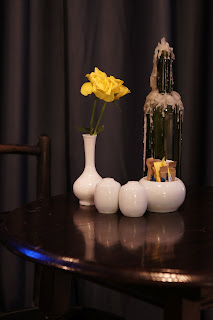Aim: The aim of this exercise is to compare the different qualities and limitations of tungsten and fluorescent lighting.
Approach and results:
Part 1 - Tungsten. The first part of this exercise involves taking a series of meter readings to see how bright the conditions are under tungsten lighting. I used the living room at dusk and using the evaluative metering at ISO200 I recorded 1/125sec near the light source and 2" in the darkest corner. Taking this further I used the spot meter on the light bulb to get 1/1250 and in the darkest part of the darkest corner I got 8". Using the spot meter showed the extremes but is not very useful, however I was curious! What it does highlight is that the light is much weaker than daylight.
I then set up a still life shot that had tungsten light and fading daylight in the shot and took three exposures. The first uses Auto WB, the second tungsten balanced and the third is daylight balanced. The first two shots are similar whilst the third shot is much cooler. Te auto white balance has obviously chosen a tungsten value, which probably means that this was the more dominant light source. The daylight balanced shot shows how much cooler tungsten light is compared to daylight.
 |
| Auto WB |
 |
| Tungsten WB |
 |
| Daylight WB |
Part 2 - For this part of the exercise I needed two different interiors lit by flourescent lamps. I chose a shopping centre and a theatre cafe as my two venues. The aim was to take the same scene with auto and flourescent WB settings and compare the outcome.
The first two images were taken in the shopping centre on a small pocket camera (as photos are not permitted). The first shot is the auto WB and the second is the flourescent. The auto setting handled the situation better than the flourescent setting which surprises me. There is a pink cast on the second shot. I think the main issue is finding somewhere that is purely flourescent lighting. There was a mixture of artificial lighting here, and in all the other places I visited. The different shops, the cafe I was in and the shopping centre itself have different lighting.
 |
| Auto white balance |
 |
| Flourescent white balance |
The next three shots were taken in the theatre cafe on an SLR. The first shot is the auto WB and the next two are different flourescent sttings. A different camera and a different setting but similar results. I prefer the auto WB result. Again there was a mixture of lighting and also possibly some daylight.
 |
| Auto white balance |
 |
| Flourescent white balance |
 |
| Flourescent white balance |
Learning points;
Artificial light is generally much weaker than daylight.
Internal scenes often have a mixture of light that needs to be balanced. Quite often a WB setting on a camera will be too specific, for example flourescent or tungsten.
In tricky scenes I usually use the manual kelvin scale to 'dial in' an accurate temperature.
No comments:
Post a Comment